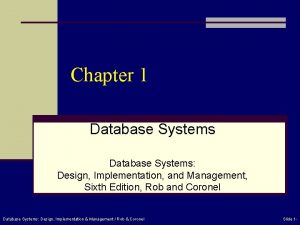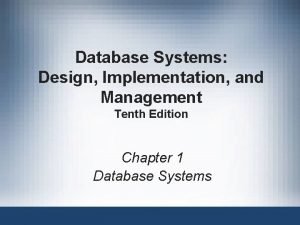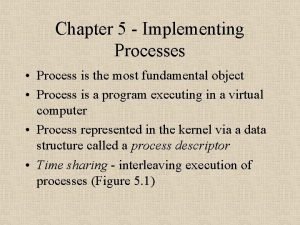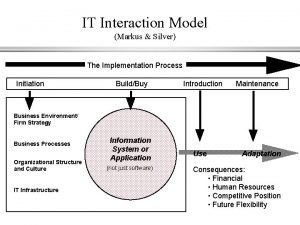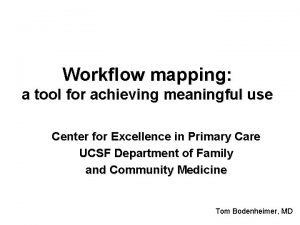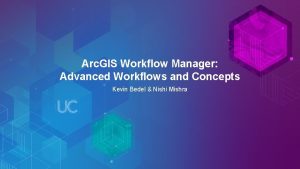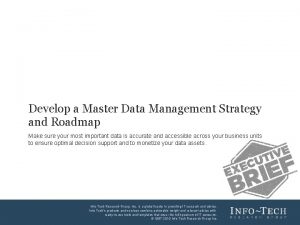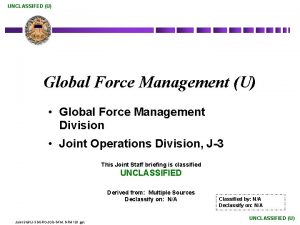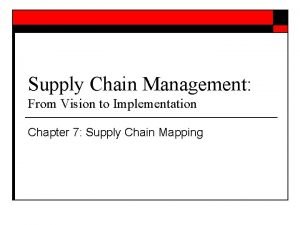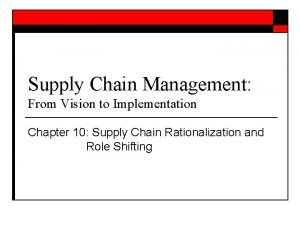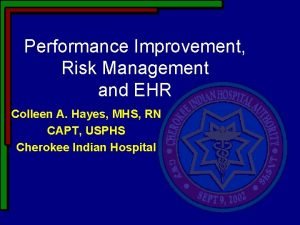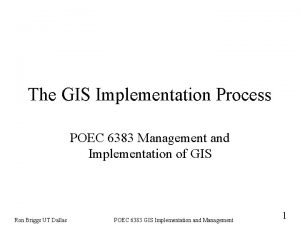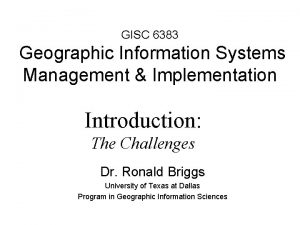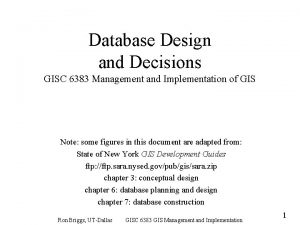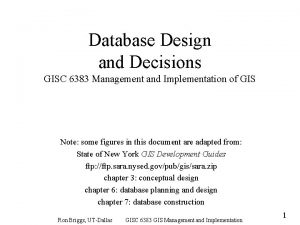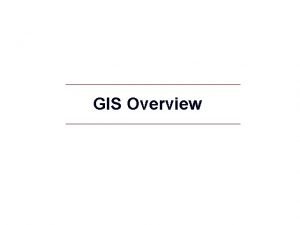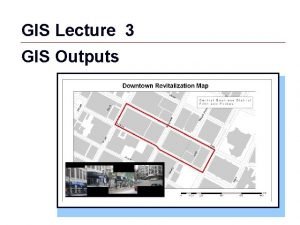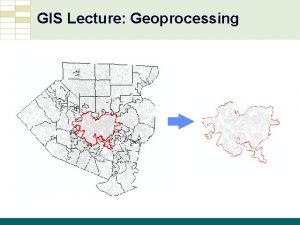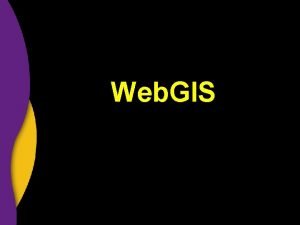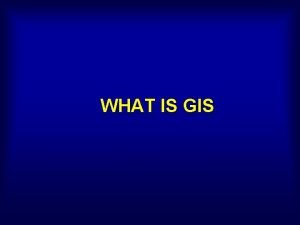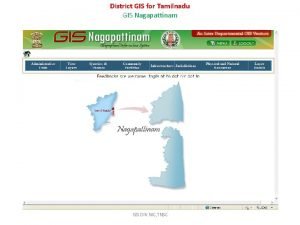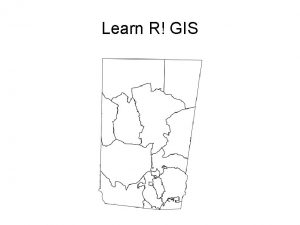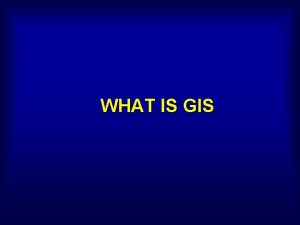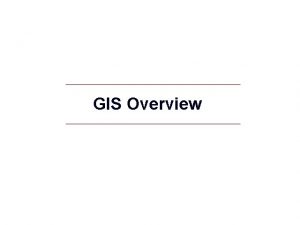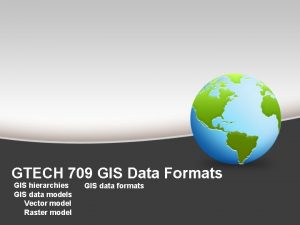The GIS Implementation Process POEC 6383 Management and



















- Slides: 19

The GIS Implementation Process POEC 6383 Management and Implementation of GIS Ron Briggs UT Dallas POEC 6383 GIS Implementation and Management 1

GIS Implementation • no guaranteed recipe for success • no cookie-cutter formula to apply BUT • there are general procedures and processes which help immeasurably • ignorance of problems & past failures is not bliss • to be forewarned is to be forearmed Ron Briggs UT Dallas POEC 6383 GIS Implementation and Management 2

No cookie-cutter formula ---but there are models which help Ron Briggs UT Dallas POEC 6383 GIS Implementation and Management 3

Context for Successful GIS Implementation • GIS Paradigm – Use geography as integrating framework for information • Data Management Principles – Extend data management principles to include geographic focus • Technology – Select appropriate GIS-enabling technology and plan to evolve • Organizational Setting – Organizational setting must be conducive to GIS implementation, management must make a committment Discussed these in general last week, and will be returning to them in subsequent weeks. For now, we focus on process…. Ron Briggs UT Dallas POEC 6383 GIS Implementation and Management 4

Steps in a GIS Project • I. Data acquisition (never underestimate the cost!) – – paper maps digital files remote sensing/satellite fieldwork • II. Preprocessing: preparation & integration – format conversion – digitizing and/or scanning – edge matching and rectification Appropriate for a project, but insufficient for an enterprise implementation. Ron Briggs UT Dallas • III. Data Management – variable selection & definition – table design (performance v. usability) – CRUD policies/procedures: Create (data entry), Retrieve (view), Update (change), Deletion (remove) • IV. Manipulation and Analysis (all the user cares about!) – address matching – network analysis – terrain modelling (e. g. slopes, aspects) • V. Product Generation – tabular reports – graphics (maps and charts) POEC 6383 GIS Implementation and Management 5

GIS Enterprise Planning Process: general strategy • Needs Assessment/ Requirements Study: why do it – does it support organization’s goal or strategic plan? – Huxhold Chap. 3 Strategic Planning for GIS • Conceptual Design: what it does – what business process(es) will be supported? – Huxhold Chap. 5 Systems Design Methodology • Physical design: how it will do it – hardware, software, data, applications, people & their management – Huxhold Chap. 4 Implementation Planning • Implementation: getting it going – actually doing it! – Huxhold Chap. 6 Implementation Management • On-going System Management: keeping it going – operations, maintenance, update and use – Huxhold Chap. 7 Managing the System Ron Briggs UT Dallas POEC 6383 GIS Implementation and Management 6

Strategic Business Plan • Needs Assessment/ Requirements Study – does it support organization’s goal or strategic plan? • Conceptual Design – what business process(es) will be supported? • Physical design – hardware, software, data, applications, people • Implementation – actually doing it! • On-Going System Management – managing actual system use Modified Strategic Business Plan Ron Briggs UT Dallas POEC 6383 GIS Implementation and Management Modifies organization’s structure Modifies organization’s plans GIS Enterprise Planning Process --general strategy with feedback loops 7

GIS Enterprise Planing Process: Primary Phases and Tasks to be Accomplished • Prepare Strategic Plan for GIS: longer term, more abstract, context and justification – based on organization’s strategic plan, if it has one (most public sector orgs don’t) – requires conceptual understanding of the organization • Prepare Implementation Plan: detailed blueprint for what is to be done – needs assessment/requirements (incl. hardware, software and data surveys) – conceptual design (“system design”) – physical design (“design specifications”) • data and database • applications • Manage the Actual Implementation: conduct tasks to create operational system – – – – administrative framework & staffing: responsibilities, timetables, milestones benchmarking and pilot studies This is the framework hardware & software procurement and installation that we will use for our data conversion and data base construction detailed discussion in application development later lectures, but its not training the only one. . . system installation 8 Ron Briggs UT Dallas POEC 6383 GIS Implementation and Management

GIS Development Guides State of New York, Local Government Technology Services (1997) http: //www. sara. nysed. gov/pubs/gisindex. htm Needs Assessment 1 Conceptual Design 2 Database Planning and Design Database Construction 5 6 Available Data Survey GIS System Integration 3 7 H/W & S/W Survey 4 Ron Briggs UT Dallas 9 Aquisition of GIS Hardware and Software Pilot/ Benchmark Application Development 10 GIS Use and Database Maintenance 11 8 “Its not the order or precise structure of the tasks but rather that, in one way or another, all get completed. ” POEC 6383 GIS Implementation and Management 9

Tarrant Regional Water District: • • Task One: IT Plan Request for Qualifications (1998) – provide basic IT plan relating to current and • future needs – include review of existing hardware/software – include identification of hardware, software, communications, and network requirements to support a standard GIS Task Two: GIS Environment – inventory map, record, & data sources • – inventory data being collected – definition source documents reconciliation and compilation needs – review & specify cartographic symbols • Task Three: Applications – conduct three remote application definition workshops – document 3 rd party software requirements – document application development requirements Ron Briggs UT Dallas Task Four: GIS System Development – define GIS module requirements – define GIS software requirements for desktops – evaluate RDBMS requirements – plan for development of logical and physical design for existing and proposed Arc. View data bases or any additional RDBMS related to proposed or existing GIS applications Task Five: Blue Print GIS Implementation Plan – – prepare GIS Implementation Cost estimate prepare applications development paln prepare Pilot Program design conduct implementation Planning workshop POEC 6383 GIS Implementation and Management 10

Lessons from Elsewhere --to be forewarned is to be forearmed Ron Briggs UT Dallas POEC 6383 GIS Implementation and Management 11

Lessons from Integrated Municipal Information Systems Project Huxhold (1993) • Agencies adopt GIS when they have a problem and see GIS as a solution, not because of its potential alone • shared implementations require a common goal that also reflects individual goals and is aligned with the overall goals of the organization • scope must be understood by all participants, including an understanding of potential for changes in organizational structure and procedures Ron Briggs UT Dallas POEC 6383 GIS Implementation and Management 12

Human Factors Paramount Campbell, 1992 • Organizations, and units in them, jealously guard their scope of activity and treat with suspicion proposals that may change this • administrative applications associated with cost savings are more readily accepted than decision-making applications to be used by policy makers • local communities very suspicious of developments that suggest centralization of information and therefore power • GIS techies often uncomfortable with social and political aspects of system implementation and utilization, thus need to involve politically-adept users/line managers/policy makers Ron Briggs UT Dallas POEC 6383 GIS Implementation and Management 13

Lessons from IT Applications Booth (1983) • Involve users and their bosses in systems analysis and design • define goals and objectives as completely as possible, in writing, before beginning the design • obtain written agreement from users and their bosses that the defined goals and objectives are appropriate • do not view these objectives, even though signed, as cast in concrete – allow “change orders” • realize that even experienced users have trouble visualizing what a future system can/could do • implement and install in manageable phases: – provides checkpoints on progress – allows users to see what they signed for – sustains user enthusiasm and managerial support Neither technology nor system design methodology are the keys to success, its: ---defining what the system will do ---communicating between IT folks and users/users’ bosses 14 Ron Briggs UT Dallas POEC 6383 GIS Implementation and Management

Nine Principles for GIS Implementation • • • International Association of Assessing Officials/ Urban and Regional Information. Systems Association A GIS is a data-driven, data-based information system GIS data and maps must be maintained A GIS is most useful when geographic references are registered on a consistent, continuous coordinate system A GIS has topology A GIS has many uses and should be shared by many different functions & users • • • A GIS contains hardware and software that are constantly undergoing change, which improves its functionality over time • A GIS grows incrementally in terms of technology, cost, and administrative support needs, therefore, a long-term commitment essential • A GIS causes changes in procedures, operations, and institutional arrangements among all users • A cadre of trained, educated, motivated, and dedicated people is crucial Does your plan incorporate all these principles? Ron Briggs UT Dallas POEC 6383 GIS Implementation and Management 15

Organizational Response and GIS Implementation Organizational response can assist or cripple GIS implementation at several stages: – – – – Initial commitment, both morally and $-wise Hardware/Software selection Data acquisition/development Pilot study Integration with existing information systems Applications address organizational objectives Staffing Data maintenance You’ve got to get it to go the right way at each stage. Ron Briggs UT Dallas POEC 6383 GIS Implementation and Management 16

Evolution of Issues During Implementation as implementation proceeds Campbell, (1992) • Technological, associated with system compatibility • data-related, associated with lack of consistency between data sets • organizational, associated with data ownership and control • institutional, associated with how to use data in the policy-making process Each challenge must be overcome as the implementation process proceeds. Ron Briggs UT Dallas POEC 6383 GIS Implementation and Management 17

Conclusion: GIS Implementation • GIS is both an enabling technology and a set of concepts about organizing work and data, thus it will impact an organization’s established “way of doing business” • a comprehensive, systematic approach to planning, design and implementation will more likely produce a successful GIS implementation (but no guarantees!) • management and institutional issues raise the greatest challenges, thus must be addressed • open, participative processes are more likely to deal successfully with these management and institutional issues ( and the technical ones!), therefore involve people • GIS is a complex information technology application, thus many of the same principles apply as in IT…. . . Ron Briggs UT Dallas POEC 6383 GIS Implementation and Management 18

Conclusion: Information Technology Implementation • Organizational change is both a cause and an effect of evolving information technology • Human aspects of organizational change are more important and challenging than technical aspects • While information technology can improve organizational performance, the technology alone will not transform an organization • Successful implementation depends on planned, wellconceived and managed integration of information technology change and organizational change A corresponding list of implementation challenges from an IT text! Ron Briggs UT Dallas POEC 6383 GIS Implementation and Management 19
 Poec assessment
Poec assessment Database systems: design, implementation, and management
Database systems: design, implementation, and management Database systems 10th edition
Database systems 10th edition Implementation of process in operating system
Implementation of process in operating system System implementation process under it interaction model
System implementation process under it interaction model It is the blueprint of nursing process
It is the blueprint of nursing process Workflow process mapping for ehr implementation
Workflow process mapping for ehr implementation Application of gis in natural resource management
Application of gis in natural resource management Gis workflow management
Gis workflow management Data governance strategy and roadmap
Data governance strategy and roadmap Campaign management implementation guide
Campaign management implementation guide Change management in ehr implementation
Change management in ehr implementation Global force management implementation guidance
Global force management implementation guidance Management issues central to strategy implementation
Management issues central to strategy implementation Management issues central to strategy implementation
Management issues central to strategy implementation Supply chain management process mapping
Supply chain management process mapping Supply chain management from vision to implementation
Supply chain management from vision to implementation Risk management in ehr implementation
Risk management in ehr implementation Process hierarchy in process management
Process hierarchy in process management Hát kết hợp bộ gõ cơ thể
Hát kết hợp bộ gõ cơ thể

